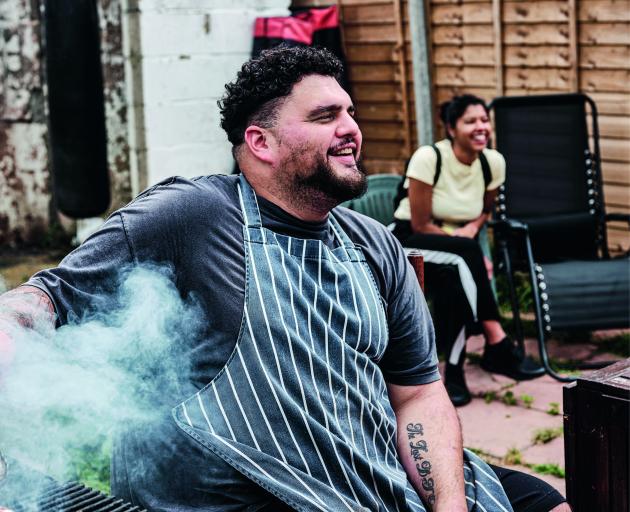
Those "Sunday Sessions" teach people how to appreciate ingredients and understand cooking - a career he came to after dropping out of school and trying his hand at a variety of jobs, from plumbing to security.
His mother suggested he audition for Jamie Oliver’s Fifteen cooking programme and through it he discovered a flair and passion for cooking. He went on to become a head chef in top kitchens before deciding he wanted to get back to cooking his own food.
Now he is releasing his first cookbook Big Has HOME: Recipes from north London to north Cyprus.
"This book is just about food. Nothing flashy, no expensive equipment and gizmos. It’s entirely about flavours and understanding. Food in its entirety is more than about filling your stomach; it’s about stories, history, and those shared moments."
In the book, Semay talks cooks through the stages of lighting a barbecue and how to prepare a variety of dishes from small plates to Turkish Cypriot classics, as well as meat and fish straight off the grill.
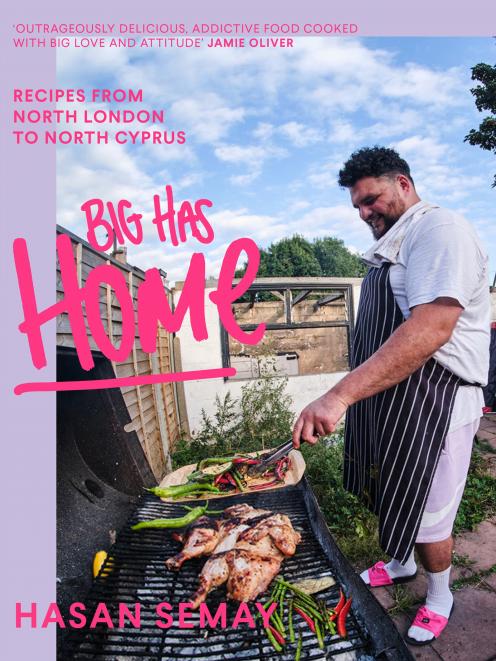
His food reflects Mediterranean influences from his Cypriot heritage as well as from his time working in professional kitchens across London.
"For me, being a Turkish Cypriot and growing up with dual nationality plays a huge part in who I am. On the outside I look like a Turkish kid, but I grew up as a Londoner first. Saying that, I’d say we grew up in a pretty Turkish house, eating Cypriot food for dinner."
It is also about capturing the "feels" and a moment in time - smells, flavour, the environment, the people around you and where you are on that day emotionally, he says.
"Food is enchanting and captivating."
His book features a lot of barbecuing. He was taught to measure the heat of a barbecue as a kid in "counts" so he uses that method in his recipes to maintain heat and be in control.
"My old man taught me a basic rule. He stuck his hand out over the fire about 13cm (5in) from the grills and counted to 5. If you put your hand over the fire and only get to a count of 1 before pulling your hand away in agony, that’s a good temperature for charring veg. A 2 count will cook fish super-fast and crispy. A 3–4 count is optimum temperature for red meat and thicker-cut steaks; still hot enough to get a good seal without f***ing your presentation. When cooking chicken, I always go for a 5 count, and especially if you’re cooking boring chicken breasts."
The book is broken into sections on small plates, Cypriot dishes, the grill, Italy and something to finish (desserts).
THE BOOK
BIG Has HOME: Recipes from north London to north Cyprus by Hasan Semay (HarperCollins, RRP $37.99). Images by Haarala Hamilton.
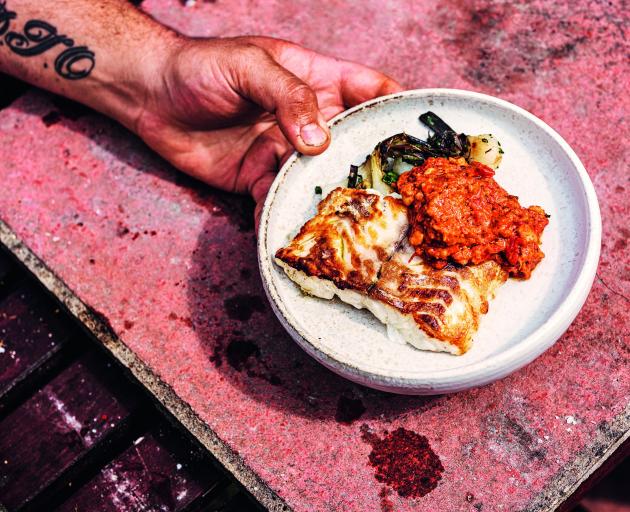
Hake, romesco and grelots
Romesco is a sauce that originates in Catalonia in Spain. It’s a popular side dish among the fishermen and traditionally made from just roasted tomatoes, garlic and hazelnuts, roasted in the oven. I like mine with grilled cherry tomatoes and red corno peppers for smokiness and a cheeky bump of paprika.
Serves 2
Ingredients
700g sweet pointed peppers
200g cherry tomatoes
4 garlic cloves, skin on
Olive oil
150g hazelnuts
1 tsp sweet paprika
1 tbsp sherry vinegar
8 Grelot onions, peeled (spring onions)
Juice of 1 lemon, plus wedges to serve
1 tsp chopped chives
Vegetable oil
2 x 300g hake fillets, skinned
Sea salt
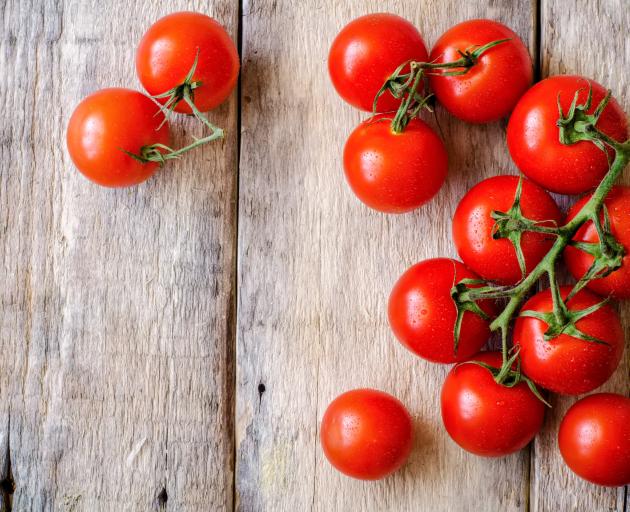
Start off by getting your grill to a 3 count (see above) and preheat the oven to 140degC fan/160degC. I don’t bother seasoning my peppers, I just stick them straight on the grill. Build the colour slowly, turning them constantly. You have to treat them with the same amount of respect as you would a big expensive steak. Blister your tomatoes and garlic cloves in a metal sieve, then season with a little glug of olive and some salt. We’re adding oil to the tomatoes because we don’t want to blacken them. When the tomatoes and garlic are soft to the touch, stick them in a warm spot on the grill so they don’t go cold. Once the peppers have gone completely soft and the skin pulls away easy, stick them in a bowl and cover with clingfilm. The clingfilm will catch the moisture from the steam in the peppers and make peeling them easier. Leave them in the bowl for at least 10 minutes.
While the peppers steam and the tomatoes keep warm, roast your hazelnuts. Spread the hazelnuts out evenly on a baking tray. Zig-zag olive oil over the top, making sure each hazelnut has a little bit. Crack over some sea salt and give the nuts a little shake to pick up any salt left on the tray. Roast in the oven for about 40 minutes or until they’ve turned a nice deep brown. Nothing too dark, just like the first three days of your holiday suntan.
Peel all the peppers, removing all the seeds, and stick them in a pestle and mortar. Add your blistered tomatoes and roasted garlic (peeled) and give them a good smash. You want to smash them pretty smooth. Add your roasted hazelnuts and break them down. At this point you’re looking for a dry red-pesto consistency. Add the paprika and sherry vinegar to the party. Add a big crack of salt and taste it should be deep, sweet, smoky, salty and finish with a little acidity. Stir through enough olive oil so you can spoon it and it holds its shape - we don’t want to drown out all the flavours we’ve spent time building.
While the grill is still hot, dress the onions with olive oil and salt. Always go olive oil first so that the salt sticks to your ingredient when cooking over fire. Grill the onions until they’ve built a nice colour all over and are soft to the touch, then take them off the grill and peel off the first layer of burnt skin. Season with olive oil, salt and lemon juice and then add your chives. I just do this on my chopping board - no point getting another bowl dirty. That’s all the outside stuff done.
Heat a frying pan over a medium heat with a little splash of vege oil. You should all invest in a good non-stick pan for cooking fish. It will save you a million times.
While your oil is heating, season your fish with salt on every side, not just top and bottom. Lay your fish in the pan away from you, removed-skin-side down. Once it’s in, leave it. We don’t want a super hard fry, keep it on medium. The fish will slowly change colour the more it cooks - keep it removed-skin-side down for a good 5 minutes.
I always cook fish 80% on one side - it gives you enough time to build that beautiful golden exterior. Have a little peek using a palette knife and see how your fish is cooking - don’t turn the fish over to look, just give it a little lift. Turn the fish over and let it cook on the other side for 1 minute. Leave the fish in the pan and turn the heat off - the fish will continue to cook slowly in the residual heat.
Put the dressed onions on the plate, fish on top and slightly off-centre, then top with a big spoonful of romesco. Zig-zag some olive oil over the top and serve with a wedge of lemon. Summer holidays mate. Gracias por favor.
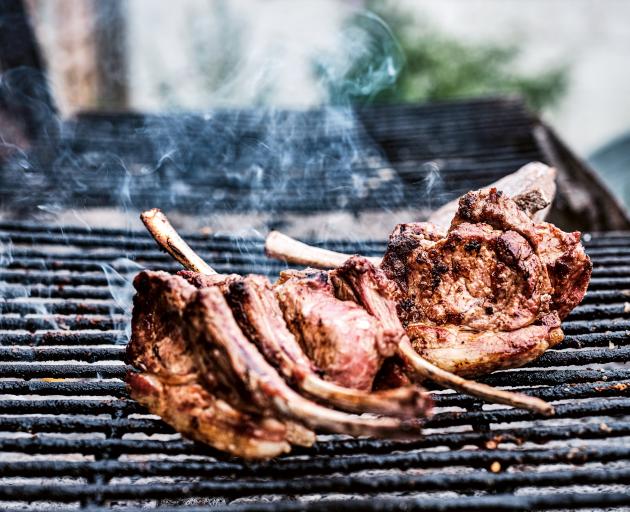
Lamb chops
This recipe means a little more to me than the rest of them. Salsa rossa is great on everything - barbecue meats, roasts, up against some veg, and I particularly like it in a cheese sandwich. This is the first recipe I ever shot with George for Jamie Oliver’s YouTube. I guess this is the birth of Sunday Sessions. I tried to make something that tasted like a kebab shop dish but a little better. Big up George each and every time.
Serves 4
Ingredients
12 lamb chops
1 lemon, cut into slices
Confit garlic
1 tsp flowering oregano
Flatbreads, to serve
For the labneh
900g full-fat yoghurt
Zest and juice of 2 limes
4 garlic cloves
2 Tbsp caster sugar
15g sea salt
For the salsa rossa
2 x 400g cans whole tomatoes, washed
4 red chillies
6 garlic cloves
Olive oil, for drizzling
2 Tbsp fennel seeds, toasted and crushed
1 Tbsp coriander seeds, toasted and crushed
A pinch of saffron (optional if you’re a millionaire)
50g runny honey
50ml white wine vinegar
Sea salt
For the onion salad
1 red onion
1 bunch flat-leaf parsley
2 pinches of sumac
Method
The labneh needs to hang overnight, so let’s start with that. Put the yoghurt in a bowl and add the lime zest and juice. Grate in the garlic, add the sugar and salt and mix well. The juice from the limes will loosen up the yoghurt but it will firm up once it’s hung it.
I don’t often have cheesecloth or muslin knocking about, so I normally run to the corner shop and buy a couple of pairs of cheap tights. The mix will fit into one leg of the tights, but if you want it done quicker, split the mix in half and use both legs. I don’t bother hanging it in the fridge. I’ll make it in the evening and hang it on the washing line. You need to make sure the tights are free-hanging as gravity is going to help with the moisture. Worst-case scenario, line a sieve with a clean cloth and add the yoghurt, keeping it over a bowl in the fridge overnight.
You can make the salsa rossa in the oven but I like to do mine on the drumbecue. It’s a barbecue in an oil drum so allows for smoking. I don’t really smoke according to different temperatures, I just light the barbecue, then let the temp come down to a 3 count, throw in a couple of logs, let them catch fire and then move them away from the fire to smoulder. Close the lid and let it do its thing.
Add the tomatoes, chillies and garlic to a roasting tray with a good glug of olive oil and a crack of salt. If you’re doing this in the oven, do the same thing and roast it at 210degC fan/230degC until the chillies start to colour and the liquid has cooked away from the tomatoes. This way, they start to become sweet and we also want a deep, rich colour on our mix.
Add your crushed spices next and fold them through, then return the tray to the oven for a further 5 minutes. Mix the honey and vinegar together. Take the tray out the oven and put it on your hob with the gas ring on underneath. Bring it up to temperature and, once it starts to fry, crush everything together with a potato masher - it doesn’t have to be completely smooth. Add in the honey mixture, with the heat on high, and deglaze the tray, scraping any bits that have stuck to the bottom. Transfer the cooked salsa to a bowl and cover with olive oil. It will keep in the fridge for a couple of weeks under oil.
If you’re cooking the salsa rossa on the barbecue, do everything the same but you won’t have to put it over the gas ring. The heat from the charcoal will do the reducing for you. For best results, I’d defo go barbecue - smoky, sweet, spicy and acidic is what we’re looking for.
The lamb chops we’re not really gonna do much to. We’ve got all sorts of flavours going on and we just want the lamb to be delicious as it is. Leave the fat on your chops, just ask your butcher to French-trim them. Don’t flatten them like they do in kebab shops. Season the lamb just with salt. Get your barbecue to a 4 count and line your chops up all together, fat-side down. The fat will slowly melt, giving you smoke clouds of flavour. Render the fat out until the fat side is golden, dancing and half the size it was originally, then rejig your charcoal so that you’ve got a solid 3 count. We want heat to build a bark on the outside of the chops. Grill the lamb chops for 2minutes on each side. I give mine a quarter turn every 30 seconds. We just want the entire exterior of our lamb to be crispy and delicious and still have a juicy pink centre. Flip them and repeat.
Make a cheeky little resting tray using the lemon slices, confit garlic and oregano. Rest the lamb in that for at least 5 minutes. We are going to flash-cook the lamb again, so it doesn’t matter if it chills in there for a little longer. While the lamb rests, slice the red onion as thin as you can get it. It’s easiest to do this on a mandoline but a sharp knife and some practise will do. Pick in the parsley leaves, add your sumac, salt and a good crack of pepper and mix with your hands.
Flash-cook your lamb for a couple minutes on each side. While the lamb is warming, throw a couple flatbreads on the grill. Once they're hot, add a good dollop of the labneh and put them on a plate. Swirl the cooked lamb chops in the resting tray and put them on top of the bread and labneh. Spoon over the salsa rossa. Plonk the onion salad on the side.
Then, the only thing missing is a glass of raki and a couple of grilled chillies.
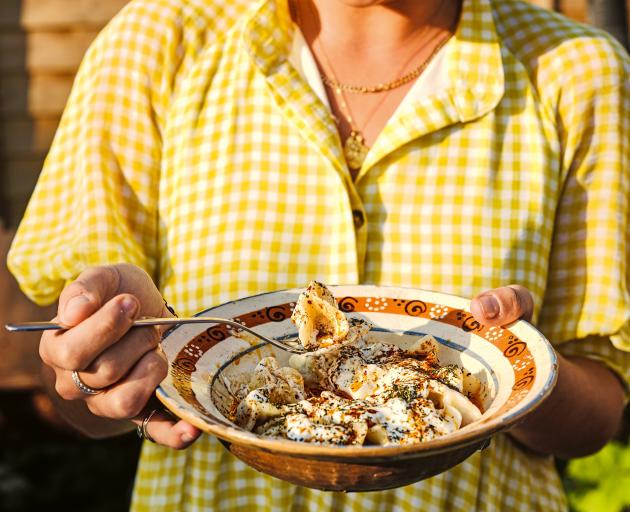
Manti
When making this, the smell in the air reminded me of my nene (Kamil’s mum). I’d often walk into the kitchen in Cyprus and she would be chopping, rolling or peeling something with her leathery-looking but somehow delicately soft hands. The horizon just peeking out of the kitchen window and the smell of fresh dough in the air. The kindest woman, whose only goal in life was to make sure everyone was fed, happy and comfortable. This one is for my nene.
Serves 4
Ingredients
For the dough
1.2kg 00 flour, plus extra for dusting
1 egg
For the filling
250g lamb mince
10g flat-leaf parsley, finely chopped
sea salt and black pepper
For the yoghurt sauce
400g yoghurt
3 garlic cloves
sea salt
To garnish
75g butter
1 Tbsp pul biber (Aleppo Turkish chilli flakes)
pinch of dried mint
Method
Start off with the dough - I made mine in a mixer. Add the egg to the flour, start to mix and slowly add 530ml water. Once it comes together evenly and there’s no flour left in the mixing bowl, tip the dough out on to your work surface and knead for 5 minutes until smooth. It’s quite a stiff dough but, once it’s smooth, wrap it in clingfilm and chill in the fridge for 1 hour.
While the dough is chilling, make the filling. Place the lamb mince in a bowl, mix in the parsley and season generously with salt and pepper.
When the dough is ready for rolling, lightly flour the work surface (don’t go too heavy as it will make shaping the dumplings harder). Split the dough into three pieces. Take a piece and roll out into a rough square - we need to get it pretty thin and you should be able to see your fingers through the dough.
Repeat this with each piece and portion the dough into 4cm squares.
Now fill each square with about ¼ tsp of filling. Honestly, this is a bit of a long process but if you get everyone together to help, you’ll smash it. Before this book, the last time I made manti was years ago and I got my mum and sister to help.
I find shaping the dumplings easier if you’re holding them in your hand. Also, my back is super bad so hunching over the worktop to roll just under 250 dumplings is back-breaking. You want the little square of dough to be the points of a compass when you look down on it. So bring south to north and pinch the two points together. Next, bring the eastern point to the top two. When folding the edges you’ll be left with two straight edges on that side; pinch those together, making sure it’s sealed. Do the same on the other side. Basically, do that 250 times and you’re done.
The yoghurt sauce is pretty straightforward. Mix the yoghurt and garlic with 3 Tbsp water in a bowl.
The last bit of prep you need to do is melt the butter until it’s brown. You want to take it to the point where it smells like butterscotch, making sure it’s golden and not burnt. Add the pul biber and take it off the heat. The pul biber will make the butter foam, so make sure you do this in a fairly deep saucepan.
Boil the little dumplings in salted water for about 3 minutes, until they start to float to the top and turn translucent.
Strain the water and spoon the dumplings out into a bowl (you need about 30 per portion). Dollop over the yoghurt you want about 2 Tbsp yoghurt per portion. Drizzle over the pul biber butter and finish with a pinch of dried mint.
Turkish pasta mate.












